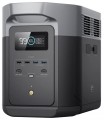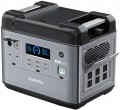Add to comparison |  |  |
|---|---|---|
| EcoFlow DELTA 2 Max | Oukitel P2001 | |
| Compare prices 5 | Compare prices 1 | |
| TOP sellers | ||
Supports up to 2 battery modules {2527847, DELTA 2 Max Battery}. LiFePO4 battery, 3000 charging cycles, 10 years of daily use until reaching 80% of the original capacity. Possibility of use as an energy independence kit for the home. | 2 USB A ports, 2 USB A Fast Charge ports, 2 USB C ports. LiFePO4 – Lithium Iron Phosphate Battery. Surges up to 4000 W are allowed. Battery capacity is 2000 Wh. | |
| In box | charging station | charging station |
| Rated power | 2400 W | 2000 W |
| Peak power | 4800 W | 4000 W |
| Output waveform | sinusoid (PSW) | sinusoid (PSW) |
| UPS function | ||
Outputs | ||
| Sockets (230 V) | 4 | 3 |
| USB A | 2 5В/2.4А 12 W | 2 5В/2.4А 12 W |
| USB A (quick charge) | 2 5В/2A, 9В/2A, 12В/1.5A 18 W | 2x QC3.0 18 W |
| USB C | 2 5 A 100 W | 2 5 A 100 W |
| Car cigarette lighter | ||
Inputs (station charging) | ||
| From solar panels | ||
| Input port XT60 | ||
| Anderson port | 12 – 48 H / 15 A | |
| Add. ports | C13/14 (charging) | |
Battery and charging time | ||
| Connecting an additional battery | ||
| Battery type | LiFePO4 | LiFePO4 |
| Battery capacity | 2048 W*h | 2000 W*h |
| Charging cycles | 3000 | 3500 |
| Charging time (socket) ≈ | 53 min | 108 min |
| Charging time (socket + solar panel) ≈ | 43 min | |
| Charging time (solar panel) ≈ | 138 min | 240 min |
| Charging power (socket) | 2400 W | 1100 W |
| Charging power (solar panel) | 1000 W | 500 W |
General | ||
| Smartphone synchronization | Bluetooth and WiFi | |
| PSU | built into the body | built into the body |
| Display | ||
| Backlight | ||
| Carrying handle | ||
| Operating temperature | 0 – 45 °C | 0 °C ~ +40 °C |
| Dimensions | 497x242x305 mm | 394x279x330 mm |
| Weight | 23 kg | 22 kg |
| Warranty | 5 years | 3 years |
| Added to E-Catalog | september 2023 | february 2023 |
When comparing the EcoFlow DELTA 2 Max and Oukitel P2001 charging stations, it's worth noting that the DELTA 2 Max offers a higher rated power of 2400 W and a peak power of 4800 W, while the P2001 has 2000 W and 4000 W respectively. Users report that the DELTA 2 Max charges faster (53 minutes from the grid) compared to 108 minutes for the P2001. Both devices have a UPS function and support charging from solar panels, but the DELTA 2 Max has a larger battery capacity (2048 Wh compared to 2000 Wh for the P2001) and more charging cycles (3000 compared to 3500). However, the P2001 is lighter and more compact, which can be an advantage for mobile use. Overall, the DELTA 2 Max is more powerful and faster, while the P2001 offers good capacity and convenience for portability.